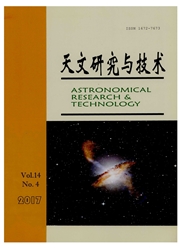

 中文摘要:
中文摘要:
介绍了低频射电干涉阵的发展情况、研究领域,讨论了国际上的LOFAR、LWA和MWA等低频射电项目。借鉴当今的低频射电项目,结合云南的地理和太阳射电优势,设想在云南省内构建一个太阳低频射电干涉阵,观测频率在30MHz~250MHz范围内,文中仿真了太阳低频射电干涉阵(4台站),比较和分析了通过优化算法得到的阵列的UV覆盖、脏束(Dirtybeam);讨论了低频射电干涉阵的观测模式、射电干扰、低频射电成像等问题;分析低频射电阵在观测太阳爆发性活动产生的日冕物质抛射(Coronal Mass Ejections,CME)、耀斑、射电爆发的可能性;通过上述的仿真和分析构建太阳低频射电干涉阵面临的问题,可以为今后建立阵列提供依据。
 英文摘要:
英文摘要:
This paper describes Low-Frequency Radio Interferometry Arrays, such as the LOFAR, LWA, and MWA projects. Based on reviewing various such arrays and advantages of the geography of Yunnan (particularly relevant to solar radio observations ), we envisage to build a Low-Frequency Solar Radio Interferometry Array in the Yunnan Province, with the observation frequency range from 30MHz to 250MHz. We have simulated the UV coverage diagrams and the dirty beam maps under different station-weighting methods, for the array design of four existing stations array and an optimized array design. We discuss observation modes, radio interferences, low-frequency radio imaging, and other issues for this array. We finally analyze the possibility of observing solar CME , flares, and radio bursts with the proposed array.
 同期刊论文项目
同期刊论文项目
 同项目期刊论文
同项目期刊论文
 期刊信息
期刊信息
